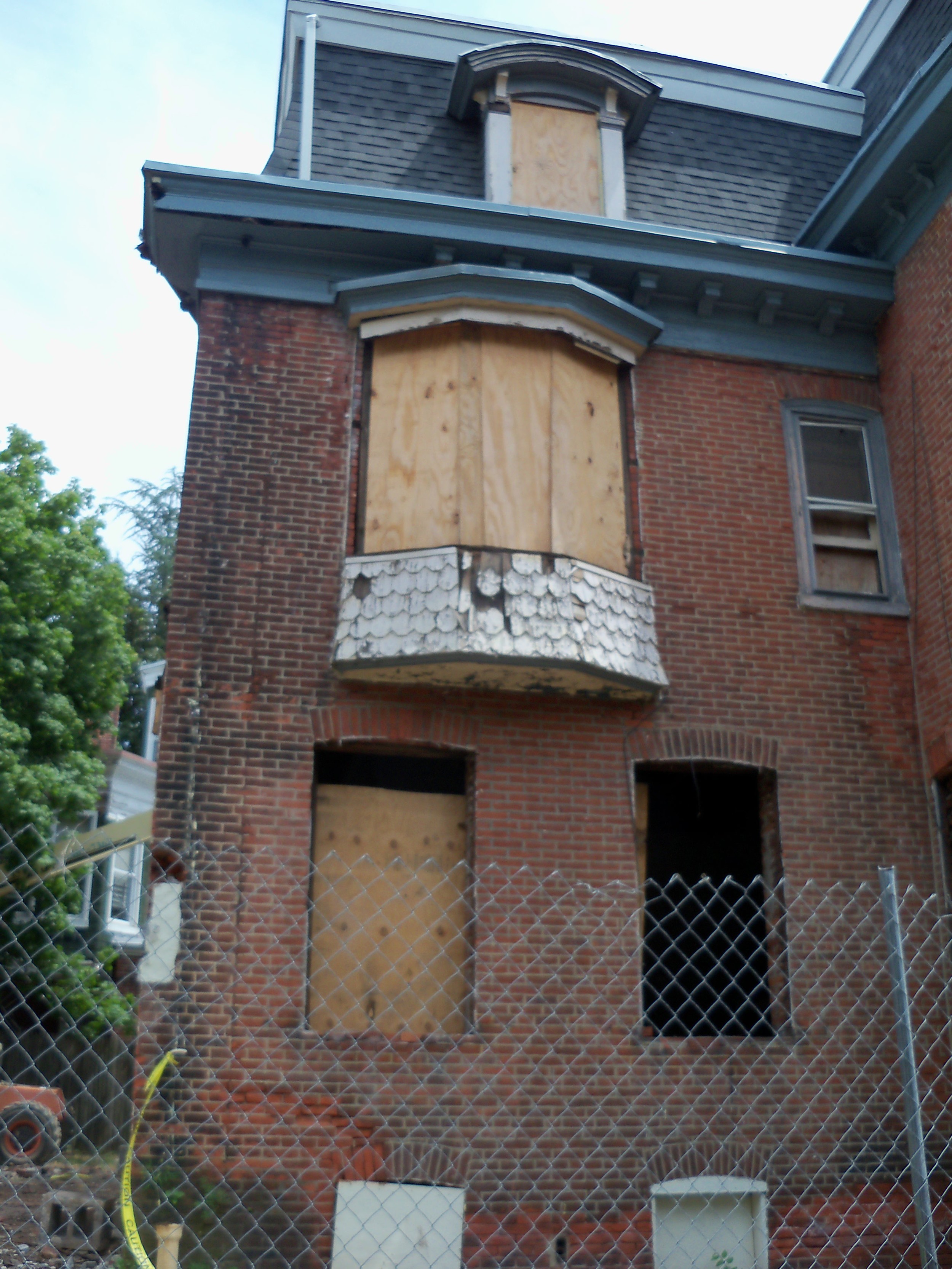Demolition By Neglect
Published by the National Trust for Historic Preservation, all rights reserved. The full text can be found by clicking HERE.
“Demolition by Neglect” is the term used to describe a situation in which a property owner intentionally allows a historic property to suffer severe deterioration, potentially beyond the point of repair. Property owners may use this kind of long-term neglect to circumvent historic preservation regulations.
Contexts in Which Demolition by Neglect Arises
Sometimes demolition by neglect occurs when an owner essentially abandons a historic property. More often, neglect is an affirmative strategy used by an owner who wants to develop the property. The context in which the issue is raised depends on what action the city decides to take, if any.
At one end of the spectrum, some local governments have taken affirmative enforcement actions against the owners of such properties, ultimately going to court if necessary. At the other end of the spectrum, occasionally the owner of a neglected or deteriorating property will file a lawsuit against the local government, challenging the historic designation or some other feature of the preservation ordinance. The problem with both of these extremes is that courts are very unpredictable.
More commonly, demolition by neglect controversies end up somewhere in the middle of this spectrum, with the local government issuing citations to repair the building, and the owner ignoring the citations. The skirmishes involved in this process often result in a statement that leaves all sides frustrated.
Demolition by Neglect and Economic Hardship
Property owners using demolition by neglect as a tactic to work around preservation laws will often argue that the prohibitive cost of repairs and deferred maintenance creates an economic hardship.
Ideally historic preservation ordinances need a safeguard provision to protect against this kind of argument, creating a loophole. Generally, the owner’s own neglect should not be allowed to create an economic hardship. However, it is often difficult to sort out the extent to which an economic hardship is attributable to an owner’s actions, or to things beyond the owner’s control (i.e., circumstances that would have existed in any event). In looking at economic hardship and demolition by neglect, it is important for commissions to look beyond simply the relationship between the cost of repairs and the purchase price or the “as is” value.
Tools for Controlling Demolition by Neglect
The most important tool for controlling demolition by neglect is a carefully drafted provision in the local preservation ordinance requiring affirmative maintenance and ensuring that the local commission is equipped with adequate remedies and enforcement authority. Even if a community already has some type of affirmative maintenance provision, it may want to review your ordinance and amend it in order to increase its effectiveness.
The first step is to look at the state’s enabling legislation to determine the specific legal authority for affirmative maintenance provisions. Affirmative maintenance provisions have repeatedly been upheld and enforced by the courts. The leading case is Maher v. City of New Orleans, 516 F.2d 1051 (5th Cir. 1975), cert. denied, 426 U.S. 905 (1976), in which a federal appeals court upheld an affirmative maintenance provision for the French Quarter in New Orleans, ruling that the provision was constitutional as long as it did not have an unduly burdensome effect on the individual property owner. In Harris v. Parker, Chancery No. 3070 (Cir. Ct. Isle of Wight County, Va. Apr. 15, 1985), a case from Smithfield, Virginia, the court actually ordered repairs to be carried out in compliance with the affirmative maintenance requirements in the ordinance. And in Buttnick v. City of Seattle, 719 P.2d 93, 95 (Wash. 1986), the court ruled that requiring an owner to replace a defective parapet on a historic building did not result in unreasonable economic hardship. The D.C. Court of Appeals in District of Columbia Preservation League v. Department of Consumer and Regulatory Affairs, 646 A.2d 984 (D.C. App. 1994), reversed the District of Columbia’s approval of the demolition of a historic landmark in dilapidated condition caused by the owner’s own actions, because the demolition permit was unauthorized under the District’s preservation act. With the help of its city attorneys, the New York Landmarks Commission has successfully obtained judgments against owners of historic buildings in particularly egregious condition. In 2004, a New York City trial judge ordered the owners of the landmarked “Skidmore House” in Manhattan to make all repairs ordered by the Landmarks Commission and to keep the building in “good repair.” See City of New York v. 10-12 Cooper Square, Inc., 793 N.Y.S.2d 688 (N.Y. Cty. 2004). On May 21, 2009, a Manhattan judge ordered the owner of the vacant Windermere Apartment Complex to maintain and repair the complex’s three buildings and to pay $1.1 million in civil penalties.
When drafting an affirmative maintenance provision, it is important to mandate coordination between the preservation commission and the building code enforcement office, to ensure that the commission is consulted before code citations and enforcement orders are issued. Be specific in defining what repairs will be required, and what remedies will be available under what circumstances. Also make sure that the economic hardship provision is drafted so that it prevents owners from arguing that their own neglect has caused an economic hardship.
One important remedy to include in the ordinance is the authority for the local government to make the repairs directly and then charge back the owner by placing a lien on the property. In some jurisdictions, such as New York City, civil penalties up to the fair market value of the property may be levied against violators.
Incentive Programs and Other Forms of Assistance
Another important tool for controlling demolition by neglect and increasing the effectiveness of affirmative maintenance programs is the use of incentives. Tax incentives, low cost loans, and grants are always encouraged as a way to help owners fund necessary maintenance.
Maintenance expenses can also be defrayed through the use of volunteer maintenance crews.
Enforcement
One reason why demolition by neglect is such a frustrating issue for preservationists and historic preservation commissions is that it often involves a branch of local government over which preservationists have little influence or control—the code inspection and enforcement office.
Most preservation groups have good relationships with their preservation commissions, but probably no relationship at all with the building inspection office.
There is often a conflict between these two governmental functions. Even under the best of circumstances, these two offices rarely coordinate their actions. At worst, an outright turf battle may erupt, in which the code enforcement office orders a building demolished as a safety hazard without consulting the preservation commission.
It is therefore very important for local preservation groups to get to know code enforcement officials. A good working relationship with these officials can be critical to helping to ensure that deferred maintenance problems are identified and corrected before they reach the point of demolition by neglect.
Selected Examples of Demolition by Neglect Provisions
Cited below are:
• Examples of provisions in state historic preservation enabling laws authorizing localities to prevent the destruction of historic buildings by "demolition by neglect;”
• Sample local ordinance provisions dealing with demolition by neglect through maintenance requirements; and
• Examples of the use of eminent domain to prevent demolition by neglect.
State Enabling Legislation
A number of states permit local governments to prevent the "demolition by neglect" of historic properties. Below are some examples of provisions in state enabling laws for historic preservation intended to address this problem:
North Carolina: "The governing board of any municipality may enact an ordinance to prevent the demolition by neglect of any designated landmark or any building or structure within an established historic district. Such ordinance shall provide appropriate safeguards to protect property owners from undue economic hardship."
Rhode Island: "Avoiding demolition through owner neglect. a city or town may by ordinance empower city councils or town councils in consultation with the historic district commission to identify structures of historical or architectural value whose deteriorated physical condition endangers the preservation of such structure or its appurtenances. The council shall publish standards for maintenance of properties within historic districts. Upon the petition of the historic district commission that a historic structure is so deteriorated that its preservation is endangered, the council may establish a reasonable time not less than 30 days within which the owner must begin repairs. If the owner has not begun repairs within the allowed time, the council shall hold a hearing at which the owner may appear and state his or her reasons for not commencing repairs.
If the owner does not appear at the hearing or does not comply with the council's orders, the council may cause the required repairs to be made at the expense of the city or town and cause a lien to be placed against the property for repayment."
Alabama: "Demolition by neglect and the failure to maintain an historic property or a structure in an historic district shall constitute a change for which a certificate of appropriateness is necessary.”
Wisconsin: "[A] political subdivision may acquire by gift, purchase, or condemnation any property right in historic property, whether the property is real or personal."
Local Ordinance Provisions Concerning Demolition by Neglect
Many local ordinances include provisions for dealing with the problem of demolition by neglect.
Some noteworthy examples are described below:
San Francisco: Language in the San Francisco ordinance is quite explicit and detailed with respect to the problem of demolition by neglect:
"Maintenance: The owner, lessee, or other person in actual charge of a Significant or Contributory building shall comply with all applicable codes, laws and regulations governing the maintenance of property. It is the intent of this section to preserve from deliberate or inadvertent neglect the exterior features of buildings designated Significant or Contributory, and the interior portions thereof when such maintenance is necessary to prevent deterioration and decay of the exterior.
All such buildings shall be preserved against such decay and deterioration and shall be free from structural defects through prompt corrections of any of the following defects:
1. Facades which may fall and injure members of the public or property.
2. Deteriorated or inadequate foundation, defective or deteriorated flooring or floor supports, deteriorated walls or other vertical structural supports.
3. Members of ceilings, roofs, ceiling and roof supports or other horizontal members which sag, split or buckle due to defective material or deterioration.
4. Deteriorated or ineffective waterproofing of exterior walls, roofs, foundations or floors, including broken windows or doors.
5. Defective or insufficient weather protection for exterior wall covering, including lack of paint or weathering due to lack of paint or other protective covering.
6. Any fault or defect in the building which renders it not properly watertight or structurally unsafe."
Culpeper, Virginia: A somewhat different approach has been taken by the town of Culpeper, which states in its ordinance:
"Sec. 28-27.2. Demolition By Neglect. No officially designated historic landmark or contributing structure within the historic district shall be allowed to deteriorate due to neglect by the owner which would result in violation of the intent of this Section.
Demolition by neglect shall include any one or more of the following courses of inaction or action:
1. Deterioration of the exterior of the building to the extent that it creates or permits a hazardous or unsafe condition.
2. Deterioration of exterior walls or other vertical supports, horizontal members, roofs, chimneys, exterior wall elements such as siding, wooden walls, brick, plaster, or mortar to the extent that it adversely affects the character of the historic district or could reasonably lead to irreversible damage to the structure.
In the event the Culpeper County Building Official, or the agent officially recognized by the
Town of Culpeper as serving that capacity, determines a structure in a historic district is being 'demolished by neglect', he shall so notify the Chairperson of the Historic and Cultural
Conservation Board, stating the reasons therefor, and shall give the owner 30 days from the date of the notice to commence work rectifying the specifics provided in the notice; or to initiate proceedings as provided for in Section 28-27. If appropriate action is taken in this time, the Town may initiate appropriate legal action as provided therein."
Charlottesville, Virginia: The Charlottesville ordinance not only requires the maintenance of a landmark property but also requires the maintenance of the land on which the landmark sits.
Note the following: "Section 31-141. Maintenance and repair required.
Neither the owner of nor the person in charge of a structure or site in any of the categories set forth in section 31-127.2 of this Code shall permit such structure, landmark or property to fall into a state of disrepair which may result in the deterioration of any exterior appurtenance or architectural feature so as to produce or tend to produce, in the judgment of the appropriate board, a detrimental effect upon the character of the district as a whole or the life and character of the landmark, structure or property in question, including but not limited to:
1. The deterioration of exterior walls or other vertical supports;
2. The deterioration of roofs or other horizontal members;
3. The deterioration of exterior chimneys;
4. The deterioration of crumbling of exterior plasters or mortar;
5. The ineffective waterproofing of exterior walls, roofs and foundations, including broken windows or doors;
6. The peeling of paint, rotting, holes and other forms of decay;
7. The lack of maintenance of surrounding environment, e.g., fences, gates, sidewalks, street signs, accessory structures and landscaping (emphasis added);
8. The deterioration of any feature so as to create or permit the creation of any hazardous or unsafe condition or conditions.
The enforcing officer shall give notice by certified or registered mail of specific instances of failure to maintain or repair. The owner or person in charge of such structure shall have sixty days to remedy such violation; provided, that the appropriate board, upon request, may allow an extension of up to sixty days to remedy such violations. Thereafter, each day during which there exists any violation of this section shall constitute a separate violation and shall be punishable as provided in articles XXVIII of this chapter."
Montgomery County, Maryland: Montgomery County requires a public hearing when charges of demolition by neglect are raised. If a property owner has been requested to maintain his property but refuses to do so, the ordinance allows the director of the county's Department of Environmental Protection may arrange for necessary repairs and charge the expenses to the owner.
"Sec. 24A-9. Demolition by Neglect.
... In the event the corrective action specified in the final notice is not instituted within the time allotted, the Director may institute, perform and complete the necessary remedial work to prevent deterioration by neglect and the expenses incurred by the Director for such work. Labor and materials shall be a lien against the property, and draw interest at the highest legal rate, the amount to be amortized over a period of 10 years subject to a public sale if there is a default in payment.” (Emphasis added.)
Portland, Maine: Portland permits its Department of Planning and Urban Development to order property owners to make necessary repairs to deteriorating buildings within specified time periods. The city also spells out in its ordinance procedures for appealing such orders.
"Section 14-690. Preservation of Protected Structures (a) Minimum Maintenance requirement. All landmarks, and all contributing structures located in an historic district, shall be reserved against decay and deterioration by being kept free from the following structural defects by the owner and any other person or persons who may have legal custody and control thereof. (1) Deteriorated or inadequate foundation which jeopardizes its structural integrity; (2) Defective or deteriorated floor supports or any structural members of insufficient size to carry imposed loads with safety which jeopardize its structural integrity;(3) Members of walls, partitions or other vertical supports that split, lean, list or buckle due to defective material or deterioration which jeopardize its structural integrity; (4) Structural members of ceilings and roofs, or other horizontal structural members which sag, split or buckle due to defective materials or deterioration or are of insufficient size to carry imposed loads with safety which Jeopardize its structural integrity; (5) Fireplaces or chimneys which list, bulge or settle due to defective material or deterioration or are of insufficient size or strength to carry imposed loads with safety which jeopardize its structural integrity; (6) Lack of weather protection which jeopardizes the structural integrity of the walls, roofs, or foundation; (b) The owner or such other person shall repair such building, object, or structure within a specified period of receipt of a written order to correct defects or repairs to any structure as provided by subsection (a) above, so that such structure shall be preserved and protected in accordance with the purposes of this article. (c) Any such order shall be in writing, shall state the actions to be taken with reasonable particularity, and shall specify dates for compliance which may be extended by the Department (of Urban Planning and Development) for reasonable periods to allow the owner to secure financing, labor or materials. Any such order may be appealed to the Board of Appeals within 30 days. The Board shall reverse such an order only if it finds that the Department had no substantial justification for requiring action to be taken, that the measures required for time periods specified were not reasonable under all of the circumstances. The taking of an appeal to the Board or to Court shall not operate to stay any order requiring structures to be secured or requiring temporary support unless the Board or Court expressly stay such order. The City shall seek preliminary and permanent relief in any court of competent jurisdiction to enforce any order." The Portland ordinance also deals firmly with people who violate these and other provisions. In addition to having to pay fines for "each day on which there is failure to perform a required act," the ordinance applies a sort of "scorched earth" policy: If a person violates the ordinance either willfully or through gross negligence, he may not obtain a building permit for any alteration or construction on the historic landmark site for five years. Moreover, for a period of 25 years, any alteration or construction on the property is subject to special design standards imposed in the ordinance, whether or not the property involved is historic.
Eminent Domain
Several cities authorize the use of eminent domain as a means of protecting historic buildings from deterioration or neglect. Specific examples include:
San Antonio, Texas: San Antonio permits the city to "condemn the [historic] property and take it by the power of eminent domain for rehabilitation or reuse by the city or other disposition with appropriate preservation restrictions in order to promote the historic preservation purposes of [the ordinance] to maintain the structure and protect it from demolition."
Richmond, Virginia: Chapter 10, Section 21, of the Code of Virginia states that the Department of Conservation shall have the power to acquire, by purchase, gift or eminent domain, properties of scenic and historical interest which in the judgment of the Director of the Department should be acquired, preserved and maintained for the use and pleasure of the people of Virginia. (Emphasis added)
Richmond, Va., recently obtained a charter change that allows the city to condemn and acquire properties in historic districts suffering from demolition by neglect. The city is currently using this authority to save a Greek Revival house in the Church Hill Historic District.
Baltimore, Maryland: Though not a recent example, the City of Baltimore exercised its eminent domain authority to acquire the historic Betsy Ross House in order to preserve it. In
Flaccomio v. Mayor and Council of Baltimore, 71 A.2d 12 (Md. 1950), the Maryland Court of Appeals upheld the city's use of this power.
Louisville, Kentucky: In the late 1970s, the City of Louisville condemned two Victorian townhouses that Louisville the Louisville Women's Club planned to demolish for a parking lot. The city then resold the properties, with preservation covenants attached, to a developer. The Club took the city to court, but the court upheld the city's action.
Please visit www.preservationnation.org for more information.

















